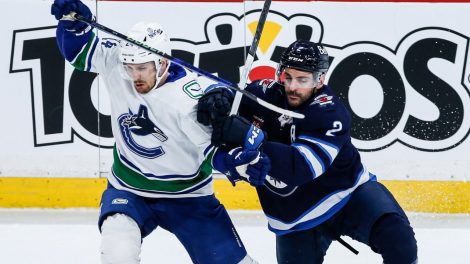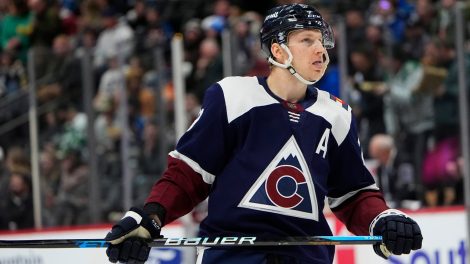It was the better part of a century ago that Canadians were introduced to the hockey broadcast.
We fell for it quickly and we still like it.
More NHL on Sportsnet:
Subscribe: Rogers GameCentre Live
Rogers Hometown Hockey | Broadcast Schedule
Sportsnet Fantasy Hockey
Foster Hewitt, who eventually became synonymous with how we accessed our game, was a tech geek, a bit of a forward thinker. He was obsessed with radio, an emerging technology when he was still a University of Toronto student in the early 1920s. He worked part time for a business – Independent Telephone Company – that manufactured the devices, which were being sold as fast as they could be built to Canadians eager to connect with a larger world with which they clearly wanted to be a part of.
It was a way to feed the imagination, which is never satisfied, and Hewitt sensed that early.
He left school and his job to start with the Toronto Daily Star (his father was the sports editor) when he learned the newspaper was going to start its own radio station (convergence!) and so he was well-positioned when CFAC Radio began broadcasting hockey games. There were challenges: His early calls were from a 4×3 glass cube at rink side (think in a sawed-off phone booth) that he fogged up with his own body heat.
“The players floated by as if on clouds,” he would say.
The view has improved considerably in the 91 years since, and Canadians will get a chance to see the game as it’s never been shown before beginning tonight when they get to see what a $5.2-billion investment in hockey broadcasting looks like when the Toronto Maple Leafs and the Montreal Canadiens faceoff for Scotiabank Wednesday Night Hockey.
Some things won’t change — cannonading drives, thundering hits and rapier-like saves are timeless — but it will be different.
“We’ve always wanted to show hockey this way,” says Gord Cutler, Rogers senior vice president for NHL production, the man who has been trying to recalibrate hockey broadcasting since Rogers bought the NHL rights for Canada. “We’ve always wanted to do more, show more, but we couldn’t do it. But technology has caught up. We can execute what we’ve seen in our imaginations.”
While hockey fans once had to rely on what Hewitt could see through the fog or later from his perch 56 feet above the ice in his gondola at Maple Leaf Gardens, now they will be able to see a little (or maybe a lot) of almost everything from almost everywhere.
There are cameras on referees and a camera – the sky cam – that races along a rail at the speed of Phil Kessel, providing a bird’s-eye view of the developing play. There are cameras the size of water bottles on the benches that should capture every profane sputter of spittle and a star cam that focuses on the very best, all the time, waiting to capture their magic even before they manage to conjure it.
It’s not cheap — the sky cam alone was $1.7-million and the plan is to have them in all seven of the Canadian team’s arenas — but that’s the price of giving Canadians something that hasn’t been seen before.
There is a studio set that looks like a space ship and cost as much as a moon landing that will become as familiar in all its backlit, shimmering LED glory to hockey fans as those baby blue CBC blazers were a generation ago.
It’s a long way from Hewitt and his gondola – the original sky cam.
But in some ways the challenge remains the same as when the original voice of Canadian hockey coached a nation of street hockey legends to announce every tennis ball that made it past every sprawled out younger brother with his signature: “He shoots, he scores.”
The point then and now was to bring those who weren’t in the game, to the game. To deliver to the mind’s eye what it couldn’t see.
“It’s really about that question we all have which is – “what is it like,” says Cutler. “How many people have ever played in the National Hockey League? The rest of us have this hunger to know what is it like and we’re constantly trying to bridge that gap.”
So much about our relationship with hockey in Canada is couched in nostalgia. It’s our comfort food. It’s not that hockey speaks to everyone all the time – our country is too diverse for any single voice – but it’s still the language that most of us speak most often.
We either live it, or we get it.
Wednesday night some things will remain the same as they have ever been: The Toronto Maple Leafs and Montreal Canadiens will be meeting in their respective season openers for the 15th time, dating back to 1921 when the Leafs were still the St. Pats. The Leafs have the historic edge, having won nine of the past 14 including the past five in a row.
The Air Canada Centre will be sold out and the 48th Highlanders will play “The Maple Leaf Forever” as they have every opening night in Toronto since Conn Smythe thought having the pipe and drum band from his old military regiment would add some pomp to the opening ceremonies at Maple Leaf Gardens in 1931.
The difference will be for those of us at home, the millions who will be watching on television, many of whom will never set foot in the ACC or any other NHL building, for that matter.
When Foster Hewitt relied on his sharp observations to make an NHL game come alive on radio he recognized the new technology for what it was: a means by which so many could share in a single experience.
But ever since the push has been to deliver more, to get people closer to the scrapes and the bangs and the shouting on the ice. It was slow at first. When Hockey Night in Canada started on television in 1952 they only took to the air at 9 p.m., typically picking up the games at the end of the second period. It wasn’t until the late 1980s with Wayne Gretzky in Los Angeles that double-headers became the norm.
But the demand kept growing and the access kept improving. The mind’s eye gave way to HBO’s 24/7 and cameras in dressing rooms capturing the gladiators getting prepared for combat.
Wednesday night’s game is the beginning of the next great leap. In the same way that Hewitt used the latest technology of his time to provide a tease; the next 12 years will be about using the tools of our wired (or wireless) age to fill our cups.
Wednesday marks of the first of 550 games broadcast nationally across nine networks – a departure from one game a week on CBC not all that long ago. For those who want more there is the Rogers NHL GameCentre Live where more than 1,000 games will be there to be watched on smartphones and tablets.
For those who want more again there is GamePlus, a feature that allows users to effectively become their own television producers, choosing camera angles and replays as they fit.
It’s a level of technical sophistication and access that Hewitt couldn’t possibly have fathomed, even as he was trying to answer ‘what is it like?’ – while wiping away the fog on the glass caused by his breath.
There will never be an answer. We haven’t played, so we don’t know. We can’t know. More cameras, more graphics, better stories and more games can bridge that chasm between our mind’s eye and what we really want to know, but they can never really get us across.
As a result, the game and those playing it will always be the stars, removed, elevated no matter what efforts we make to bring them nearer, to see what they see and feel what they feel.
But that doesn’t mean we won’t forever want to reach out and try and touch them, to finally find out for ourselves.
Foster Hewitt got it started.
What is it like?
We’ll never know, but when the puck drops tonight we’ll be closer than we’ve ever been.










